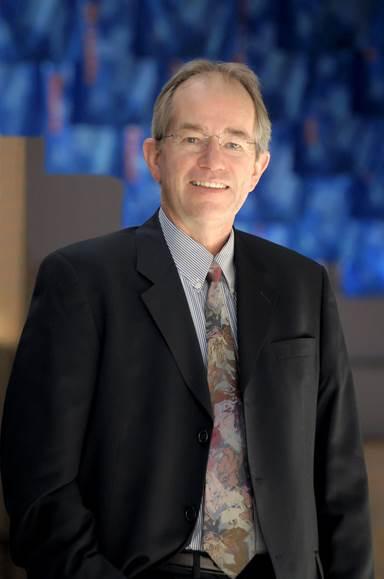Nanophotonic devices

Credit: UT Arlington
A research team from The University of Texas at Arlington is working with the Army Research Laboratory to develop nanophotonic devices that could have applications in thermal imaging and resonant filtering.
Robert Magnusson, an electrical engineering professor and the Texas Instruments Distinguished University Chair in Nanoelectronics, is the principal investigator for a $1.2 million collaborative agreement with the Army Research Laboratory.
Nanophotonic devices are used to shape the spectrum of light via photonic lattices and resonance, but their application generally has been limited to short wavelengths. The research team is trying to develop devices that will work in the longwave infrared spectral region, which is the range in which thermal radiation is emitted. In addition to thermal imaging technology, these devices could be used in sensors for medical diagnostics, chemical analyses and environmental monitoring, among other applications.
“We have made many advances in the development of photonic devices over the years, and our methodology can be really useful in this application,” Magnusson said. “There is a need to develop this technology because there is a shortage of optical components in longwave infrared bands. Changing frequency or wavelength to this region requires that we completely change our fabrication methods, and we have already successfully made devices under this new funding.”
Photonic lattices are structures–such as nanopatterned silicon films on glass substrates or arrays of nanowires–with differing refractive qualities that are arranged so they can capture, store and release light. For the new, longer wavelength devices, Magnusson will create lattices out of germanium, a metalloid element that has the properties of a semiconductor.
Daniel Carney, a recent UTA doctoral graduate, successfully developed longer wavelength devices in the University’s Shimadzu Institute Nanotechnology Research Center while a student in Magnusson’s lab. Magnusson said he plans to adapt these devices to make them tunable to specific wavelengths. By mechanically or electrically altering the device’s structure, selected wavelengths are rejected while useful imaging data passes to detection equipment.
“The Shimadzu Institute Nanotechnology Research Center was very important in the development of Daniel’s research and what we’re trying to do with the Army Research Lab,” Magnusson said. “The facility is behind experimental realization of many of the key discoveries we make.”
Magnusson, Neelam Gupta of the Army Research Laboratory and Mark Mirotznik of the University of Delaware are collaborating on the research. Their project is an example of data-driven discovery, one of the themes of UTA’s Strategic Plan 2020, said Peter Crouch, dean of the College of Engineering.
“As engineers, we always want to have an impact on society,” Crouch said. “Dr. Magnusson’s research has been at the leading edge of his field for many years, and his findings have contributed a great deal to our knowledge of photonics. This agreement with the Army Research Lab is an excellent opportunity to create devices that will make an impact for years to come.”
Magnusson has worked in photonics throughout his career and pioneered a host of device technologies, many of which are patented. He leads UTA’s Nanophotonics Device Group, which pursues theoretical and experimental research in periodic nanostructures, nanolithography, nanophotonics, nanoelectronics, nanoplasmonics and optical bio- and chemical sensors. His research established new transformative biosensor platform technology that is in commercial use by Resonant Sensors Inc., a company he co-founded.
Magnusson has garnered more than $12 million in research funding and endowments for UTA since becoming the Texas Instruments Distinguished University Chair in Nanoelectronics in 2008, published more than 450 journal and conference papers and secured 35 issued patents and pending patents.
He is a charter fellow of the National Academy of Inventors–one of 15 NAI fellows among the UTA faculty–and a Life Fellow of the prestigious Institute of Electrical and Electronics Engineers. The IEEE has singled out Magnusson for his contributions to the invention of a new class of nanophotonic devices that employ light at a nanometer scale. His devices are used as biosensors, lasers, tunable filters and optical components.
###
UTA’s Department of Electrical Engineering boasts several leading researchers in the field of photonics in addition to Magnusson:
- Weidong Zhou works with quantum sensors for detecting disease and harmful gases in the air, as well as on-chip systems for use in health care applications.
- Michael Vasilyev works with quantum optic communications for secure data transmissions and more efficient internet connections.
- Alice Sun uses lasers to build sensors that detect harmful gases in the air, as well as portable sensors that can be used in a doctor’s office to non-invasively detect cancer and other diseases.
The department’s faculty perform research in a host of areas, including electrical power systems, microgrids, power conversion and control, energy storage, sensors and robotics, unmanned vehicle systems, photonics, implantable sensors and systems, radar and wireless sensor networks, human performance and signal processing and machine learning.
— written by Jeremy Agor
Media Contact
Herb Booth
[email protected]
Original Source
https:/



